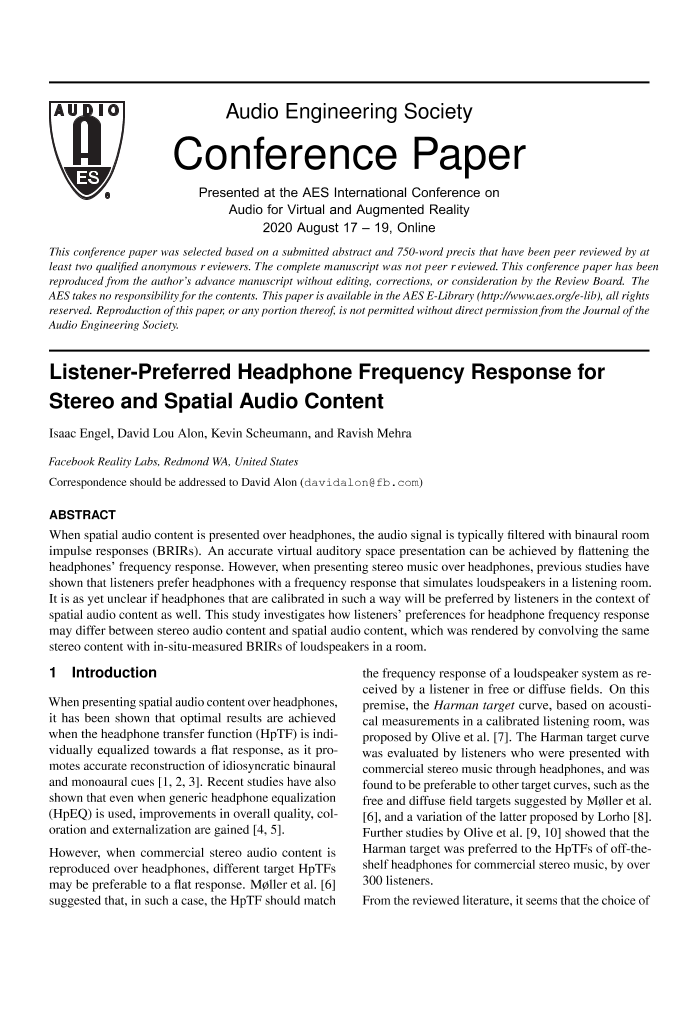In my view, "accuracy" in the stereo paradigm is pretty much limited to reproducing the event at some mastering console somewhere. For binaural recordings, we can achieve an acoustic and subjective result equivalent to the person listening to a headphone being at the same position as the binaural recording head, and the work of Gunther Thiele in this area leads me to the position that in this capacity diffuse field is most accurate.
You said it. I did not.

But I happen to agree that a rig's response to a diffuse sound field can
potentially be at least one good starting or reference point to better answering some of these questions.
There are a couple potential problems that I see though with this idea. And the first problem is that there are various different models for a diffuse sound field. So how do you decide which one is the best or most correct?... That might bring us back to the subjective testing again. And Harman actually
did some tests with a few different diffuse field models in some of their early work on developing a target headphone response curve. And found that most of them tested pretty low on the subjective tests.
One thing that they
did not test though is a diffuse sound field which has been corrected to better match the darker timbre, tilt, tonal balance, whatever, of speakers in a typical semi-reflective room. Which is a very important point imo (and something that we now also have a wealth of data on, thanks to the Klippel other anechoic spinorama measurements done by this and other speaker measurement sites).
The second problem is the
accuracy of the DF measurements. Because often the operators of these measurement rigs will make their own custom tweaks or modifications to the pinna and other equipment, which can potentially change their responses away from the factory default DF measurements, leading to inaccuracies in the DF compensation of the measurements on those rigs. This is one of the issues I seem to be encountering with at least some of the GRAS-based headphone measurements.
Based on the discussions here, and elsewhere on the subject of leakage and coupling, I think you could also add these into the mix as well. Because if there are problems getting the headphones to produce a consistent and reliable seal and response, that will also impact the efficacy of any target based on a diffuse model. Just as it would with any other model based on a fixed frequency response curve. Like the Harman target, for example.
The answer to the first problem is relatively simple imo. Because you can (imho) simply take the rig's response to a spectrally flat diffuse field, and then apply a correction to that data to better approximate the somewhat
darker overall tonal balance of a speaker's steady state response in a semi-reflective room. It seems to me that this is precisely the kind of thing that Harman's spinorama loudspeaker data was designed for. And that a speaker's overall diffuse response in a room measured at the listening position (which is represented on a spinorama graph by the
sound power curve), or something pretty close to it, is probably the appropriate tool or equivalent for this job.
Imo, this is approximated fairly well by a slope in the -1.0 to -1.5 dB per octave range. With maybe a few tweaks here and there to compensate for the directivity and other imperfections, limitations, etc. in a speaker's design.
The accuracy of the DF measurements is also not that complicated. Assuming the factory did the DF measurements well and correctly to begin with, then you just don't make any custom tweaks to the pinna or other gear, so that their response stays much better in sync with the factory's DF measurements for the rig. (The rig manufacturer has to do a good job on the DF measurements in the first place though.)
Another option is to have a rig measured for its DF response by another reputable independent source that does that kind of thing. This would also (potentially) solve the problems related to any customization done on the rig that might alter its response from the factory's default configuration and measurements.
The third problem of
consistency in the measurements is just one that the measurement operator is going to have to figure out in consultation with the rig manufacturer. Maybe some tweaks could be necessary to the rig to ensure a better and more consistent response and measurements. In which case, it might need to be re-measured again for its DF response by either the manufacturer or another source.

